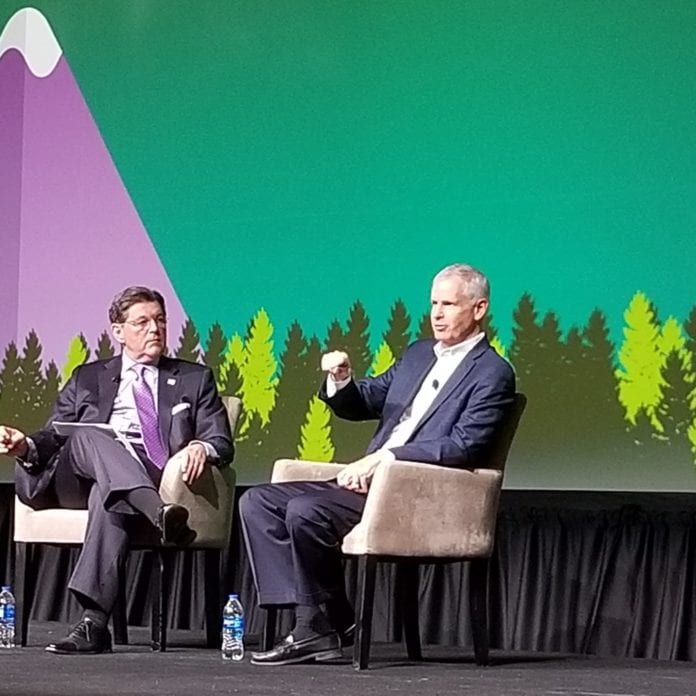AURORA, COLORADO — The reality of building out a nationwide cellular network and competing with major mobile network operators seems to be hitting home for DISH Chairman and co–founder Charlie Ergen.
Speaking at the Competitive Carriers Association’s Mobile Carrier Show, Ergen said that work on the company’s narrowband internet of things network is underway. The company has less than a year until the March 2020 Federal Communications Commission deadline by which DISH has to demonstrate significant deployment of its spectrum, or face losing those assets. The company’s plan is to build its network in two phases: a narrowband IoT network, followed up by building one of the first global standalone 5G New Radio networks in the world.
Ergen, who has at other wireless industry events casually dropped news of DISH’s intent to put $10 billion into that 5G network even as it puts up to $1 billion into a narrowband internet of things network, said that “5G is not ready for us to build out today,” going on to add that “we kind of have one tied behind our back” because DISH’s spectrum holdings include 45 megahertz of downlink spectrum but only 5 megahertz of uplink spectrum that is clear, and the rest isn’t expected to be cleared until July of 2020 — when its 600 MHz spectrum should be available for uplink purposes. But the company is working on the NB-IoT build-out currently, based on its available spectrum resources, to meet its FCC deadline.
“We’re in the midst of that build-out today. It’s harder than I thought it was going to be,” Ergen said. “But we’re learning about it, and we’re going to be successful. We’ll get there, in 332 days, with a pretty robust narrowband-IoT network.
“That is not enough to sustain the kind of capital investment we’ve made in spectrum,” he continued. “It is unlikely that we will get a return on $20-something-plus billion dollar worth of spectrum. … We’re more excited about Phase 2, because Phase 2, we think we can make a difference in … virtually every industry, in virtually everybody’s lives, and we get to attack some of the problems from climate change to health care to education. All those things need 5G as an engine.”
Ergen also acknowledged that the competitive landscape for IoT has changed since DISH first put together its network plans.
“We looked at IoT when people didn’t think that was much of a business, and we saw an opening there to do a counter-strategy of, we’ll go into IoT, in a place where nobody is,” Ergen said. “Since that point in time, [mobile network operators] also have their IoT networks up, and we won’t be the only company with an IoT network. …
“I would have said a couple of years ago that we would be very competitive, but now we have … at least four competitors in the market,” Ergen said. “But we’ll focus on some peripherals and aspects where we think we can make a difference.” He referenced DISH’s expertise in digital engineering, truck rolls to people’s homes or businesses and video as helpful skill sets the company can draw on.
“We’ll make the network open to anyone who wants to use it,” he added.
He said that in some ways, incumbents — including the network operators in the room — are at somewhat of a disadvantage in having to juggle their legacy systems and move to virtualized architectures, which Ergen described as the “biggest paradigm shift,” and one which the wireless industry needs to navigate.
But Ergen followed that up by urging companies in the room to contact him, asking for interested partners who may have towers, technicians, retail stores or other resources that DISH could leverage, while the company could offer rural carriers “a path to 5G,” Ergen said — including the future potential for a more efficient, wireless-based triple play including both mobile and fixed wireless services.
Ergen reiterated that DISH is “really, really, really committed” to its wireless network plans.
“I think you increase your odd of success when you burn the bridges,” Ergen said. “You have to be all in, and we are all in. So we’re taking every single penny that DISH has ever earned, and we’re investing that in a wireless network. And there’s no escape hatch. We’re either going to make it or we’re not.”
He compared DISH’s current situation to its early days in satellite, when it didn’t have much expertise and started small, yet managed to build its business over time.
“The big incumbents forget that they all started with their first tower,” Ergen said. “They expect DISH to suddenly have 100 million customers tomorrow, or else we’re hoarding spectrum. Well, you’ve got to start with your first tower. And we’ve started with our first tower. And then you build your business.”

